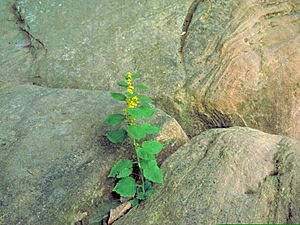Whitehair goldenrod facts for kids
Quick facts for kids Whitehair goldenrod |
|
|---|---|
 |
|
| Conservation status | |
| Scientific classification | |
| Genus: |
Solidago
|
| Species: |
albopilosa
|
The whitehair goldenrod (Solidago albopilosa) is a very special and rare flowering plant. It belongs to the aster family, which includes many well-known flowers like sunflowers and daisies.
This plant is found only in one specific place on Earth: the state of Kentucky in the Southern United States. When a plant or animal lives only in one small area, it's called endemic. Sadly, the whitehair goldenrod is a threatened species, which means it's in danger of disappearing. The United States government protects it to help it survive.
Contents
Where This Special Plant Lives
This unique plant grows only in Eastern Kentucky, in a beautiful area called the Red River Gorge. This gorge is part of the Daniel Boone National Forest. You can find the whitehair goldenrod in three counties there: Menifee, Powell, and Wolfe Counties.
It loves to live in rock shelters. These are like open caves with big rocks hanging over them. The plant grows on sandy soil that collects on the sandstone floors of these shelters. It prefers spots that are out of direct sunlight but not too dark.
What Whitehair Goldenrod Looks Like
The whitehair goldenrod is a perennial herb. This means it lives for more than two years, coming back each growing season. It has one or more straight stems that grow from a woody base.
The plant usually grows about 30 to 50 centimeters (12 to 20 inches) tall. But sometimes, it can reach up to 1 meter (about 3 feet) in height! Its stems and leaves are covered in soft, white hairs, which is how it got its common name.
Leaves and Flowers
The leaves of the whitehair goldenrod are shaped like an oval or a spatula. They have jagged edges and can be up to 8 or 9 centimeters (about 3.5 inches) long and 4 or 5 centimeters (about 2 inches) wide. The leaves get smaller as you go up the stem. They are so thin that you can almost see through them!
The plant's inflorescence (flower cluster) holds up to 30 small flower heads. Each head is only about half a centimeter (0.2 inches) long. Inside, you'll find 3 to 5 tiny yellow ray florets (like the petals of a daisy) and a few disc florets (the tiny flowers in the center).
After blooming, the plant produces fruit, which is also very small. It blooms in the fall, usually from September through November.
Plant Neighbors
The whitehair goldenrod shares its home with many other plants in the rock shelters and surrounding forest. Some of its neighbors include:
- White baneberry (Actaea pachypoda)
- Northern maidenhair fern (Adiantum pedatum)
- Jack in the pulpit (Arisaema triphyllum)
- Flowering dogwood (Cornus florida)
- Yellow mandarin (Disporum lanuginosum)
- Smooth hydrangea (Hydrangea arborescens)
- Indian cucumber-root (Medeola virginiana)
- Nepalese browntop (Microstegium vimineum)
- Partridge berry (Mitchella repens)
- Clearweed (Pilea pumila)
- Christmas fern (Polystichum acrostichoides)
- Great rhododendron (Rhododendron maximum)
- Poison ivy (Toxicodendron radicans)
- Mapleleaf viburnum (Viburnum acerifolium)
Other common plants found nearby are roundleaf catchfly (Silene rotundifolia) and littleflower alumroot (Heuchera parviflora).
Protecting the Whitehair Goldenrod
Protecting this rare plant is very important. People are working to help it survive. For example, small fences have been put up around some plants to keep them safe. Also, hiking trails are sometimes moved away from sensitive areas where the plants grow.
The biggest danger to the whitehair goldenrod comes from people enjoying outdoor activities in the Daniel Boone National Forest. Popular activities like hiking, camping, and rock climbing can accidentally harm the plants. When people walk on them, it can destroy the plants, pack down the soil, and damage their seeds and underground stems.
Sometimes, explorers go into the rock shelters. They might build fires, leave trash, or accidentally spread seeds of harmful invasive species like garlic mustard. Digging in the soil for old artifacts can also hurt the plants.
Logging (cutting down trees) is another threat. When trees are removed, more sunlight reaches the forest floor, and the soil can become drier. This can also make it easier for new, non-native plants to invade the area, which can outcompete the whitehair goldenrod.


